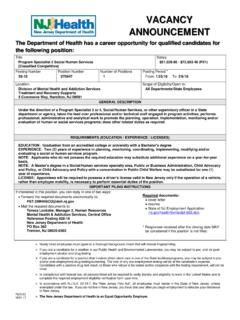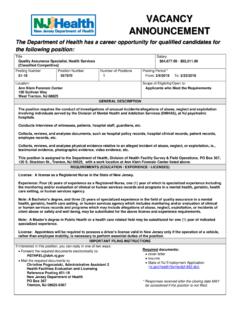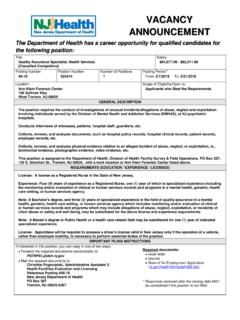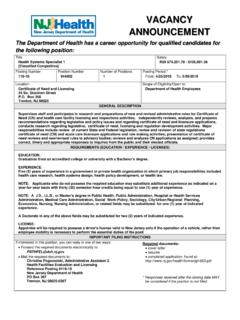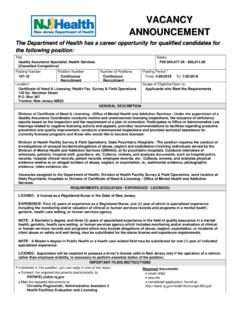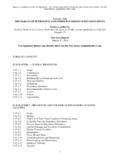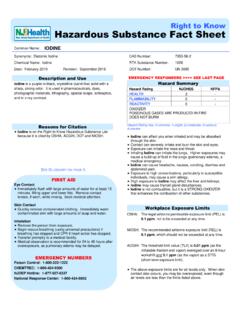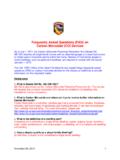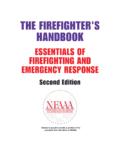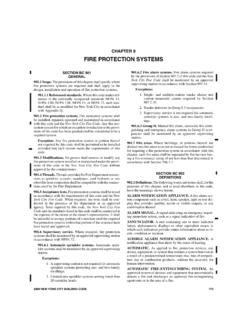Transcription of Right to Know Hazardous Substance Fact Sheet
1 Right to know Hazardous Substance fact Sheet Common Name: carbon monoxide Synonyms: Carbonic Oxide; Exhaust Gas; Flue Gas Chemical Name: carbon monoxide Date: January 2010 Revision: December 2016 CAS Number: 630-08-0 RTK Substance Number: 0345 DOT Number: UN 1016 Description and Use carbon monoxide is a colorless and odorless gas. It is mainly found as a product of incomplete combustion from vehicles and oil and gas burners. It is used in metallurgy and plastics, and as a chemical intermediate. Reasons for Citation carbon monoxide is on the Right to know Hazardous Substance List because it is cited by OSHA, ACGIH, DOT, NIOSH and NFPA. This chemical is on the Special Health Hazard Substance List. SEE GLOSSARY ON PAGE 5. FIRST AID Eye Contact Immediately flush with large amounts of water for at least 15 minutes, lifting upper and lower lids.
2 Remove contact lenses, if worn, while rinsing. Skin Contact In case of contact with liquid carbon monoxide , immerse affected part in warm water. Seek medical attention. Inhalation Remove the person from exposure. Begin rescue breathing (using universal precautions) if breathing has stopped and CPR if heart action has stopped. Transfer promptly to a medical facility. Medical observation is recommended for several days after exposure or if symptoms are present, as some symptoms may be delayed. EMERGENCY NUMBERS Poison Control: 1-800-222-1222 CHEMTREC: 1-800-424-9300 NJDEP Hotline: 1-877-927-6337 National Response Center: 1-800-424-8802 EMERGENCY RESPONDERS >>>> SEE LAST PAGE Hazard Summary Hazard Rating NJDHSS NFPA HEALTH - 2 FLAMMABILITY - 4 REACTIVITY - 0 TERATOGEN FLAMMABLE POISONOUS GASES ARE PRODUCED IN FIRE CONTAINERS MAY EXPLODE IN FIRE Hazard Rating Key: 0=minimal; 1=slight; 2=moderate; 3=serious; 4=severe carbon monoxide can affect you when inhaled.
3 carbon monoxide may be a TERATOGEN. HANDLE WITH EXTREME CAUTION. Exposure during pregnancy can cause lowered birth weight in offspring. Skin contact with liquid carbon monoxide can cause frostbite. Inhaling carbon monoxide can cause headache, dizziness, lightheadedness and fatigue. Higher exposure to carbon monoxide can cause sleepiness, hallucinations, convulsions, and loss of consciousness. carbon monoxide can cause personality and memory changes, mental confusion and loss of vision. Extremely high exposure to carbon monoxide can cause the formation of Carboxyhemoglobin and decrease the ability of the blood to carry Oxygen. This can cause a bright red color to the skin and mucous membranes causing trouble breathing, collapse, convulsions, coma and death. carbon monoxide can affect the heart and damage the nervous system. carbon monoxide is a FLAMMABLE GAS and a DANGEROUS FIRE HAZARD.
4 Workplace Exposure Limits OSHA: The legal airborne permissible exposure limit (PEL) is 50 ppm averaged over an 8-hour workshift. NIOSH: The recommended airborne exposure limit (REL) is 35 ppm averaged over a 10-hour workshift and 200 ppm, not to be exceeded during any 15-minute work period. ACGIH: The threshold limit value (TLV) is 25 ppm averaged over an 8-hour workshift. carbon monoxide Page 2 of 6 Determining Your Exposure Read the product manufacturer s Material Safety Data Sheet (MSDS) and the label to determine product ingredients and important safety and health information about the product mixture. For each individual Hazardous ingredient, read the New Jersey Department of Health Hazardous Substance fact Sheet , available on the RTK Program website ( ) or in your facility s RTK Central File or Hazard Communication Standard file. You have a Right to this information under the New Jersey Worker and Community Right to know Act, the Public Employees Occupational Safety and Health (PEOSH) Act if you are a public worker in New Jersey, and under the federal Occupational Safety and Health Act (OSHA) if you are a private worker.
5 The New Jersey Right to know Act and the PEOSH Hazard Communication Standard ( 12:100-7) requires most employers to label chemicals in the workplace and requires public employers to provide their employees with information concerning chemical hazards and controls. The federal OSHA Hazard Communication Standard (29 CFR ) requires private employers to provide similar information and training to their employees. This fact Sheet is a summary of available information regarding the health hazards that may result from exposure. Duration of exposure, concentration of the Substance and other factors will affect your susceptibility to any of the potential effects described below. Health Hazard Information Acute Health Effects The following acute (short-term) health effects may occur immediately or shortly after exposure to carbon monoxide : Skin contact with liquid carbon monoxide can cause frostbite.
6 Inhaling carbon monoxide can cause headache, dizziness, lightheadedness and fatigue. Higher exposure to carbon monoxide can cause sleepiness, hallucinations, convulsions, and loss of consciousness. carbon monoxide can cause personality and memory changes, mental confusion and loss of vision. Extremely high exposure to carbon monoxide can cause the formation of Carboxyhemoglobin and decrease the ability of the blood to carry Oxygen. This can cause a bright red color to the skin and mucous membranes causing trouble breathing, collapse, convulsions, coma and death. Chronic Health Effects The following chronic (long-term) health effects can occur at some time after exposure to carbon monoxide and can last for months or years: Cancer Hazard There is no evidence that carbon monoxide causes cancer in animals. This is based on test results presently available to the New Jersey Department of Health from published studies.
7 Reproductive Hazard carbon monoxide may be a TERATOGEN in humans since it is a teratogen in animals. There is limited evidence that carbon monoxide may damage the male reproductive system (including decreasing the sperm count) in animals. Other Effects carbon monoxide can affect the heart and damage the nervous system. Medical Medical Testing For frequent or potentially high exposure (half the TLV or greater), the following are recommended before beginning work and at regular times after that: Carboxyhemoglobin levels (a combination of carbon monoxide and hemoglobin) should be tested for within a few hours after exposure to the gas. EKG Exam of the nervous system Any evaluation should include a careful history of past and present symptoms with an exam. Medical tests that look for damage already done are not a substitute for controlling exposure. Request copies of your medical testing.
8 You have a legal Right to this information under the OSHA Access to Employee Exposure and Medical Records Standard (29 CFR ). Mixed Exposures Smoking increases your exposure to carbon monoxide . Because smoking can cause heart disease, as well as lung cancer, emphysema, and other respiratory problems, it may worsen respiratory conditions caused by chemical exposure. Even if you have smoked for a long time, stopping now will reduce your risk of developing health problems. Exposure to 30 ppm of carbon monoxide throughout the day is equivalent to smoking 20 cigarettes a day. Conditions Made Worse By Exposure Individuals who have heart disease should not be exposed to levels of carbon monoxide above 25 ppm. carbon monoxide Page 3 of 6 Workplace Controls and Practices Very toxic chemicals, or those that are reproductive hazards or sensitizers, require expert advice on control measures if a less toxic chemical cannot be substituted.
9 Control measures include: (1) enclosing chemical processes for severely irritating and corrosive chemicals, (2) using local exhaust ventilation for chemicals that may be harmful with a single exposure, and (3) using general ventilation to control exposures to skin and eye irritants. For further information on workplace controls, consult the NIOSH document on Control Banding at The following work practices are also recommended: Label process containers. Provide employees with hazard information and training. Monitor airborne chemical concentrations. Use engineering controls if concentrations exceed recommended exposure levels. Provide eye wash fountains and emergency showers. Wash or shower if skin comes in contact with a Hazardous material. Always wash at the end of the workshift. Change into clean clothing if clothing becomes contaminated. Do not take contaminated clothing home.
10 Get special training to wash contaminated clothing. Do not eat, smoke, or drink in areas where chemicals are being handled, processed or stored. Wash hands carefully before eating, smoking, drinking, applying cosmetics or using the toilet. In addition, the following may be useful or required: Specific actions are required for this chemical by OSHA. Refer to the OSHA Compressed gases Standard (29 CFR ). Before entering a confined space where carbon monoxide may be present, check to make sure that an explosive concentration does not exist. Where possible, transfer carbon monoxide from cylinders or other containers to process containers in an enclosed system. Personal Protective Equipment The OSHA Personal Protective Equipment Standard (29 CFR ) requires employers to determine the appropriate personal protective equipment for each hazard and to train employees on how and when to use protective equipment.
